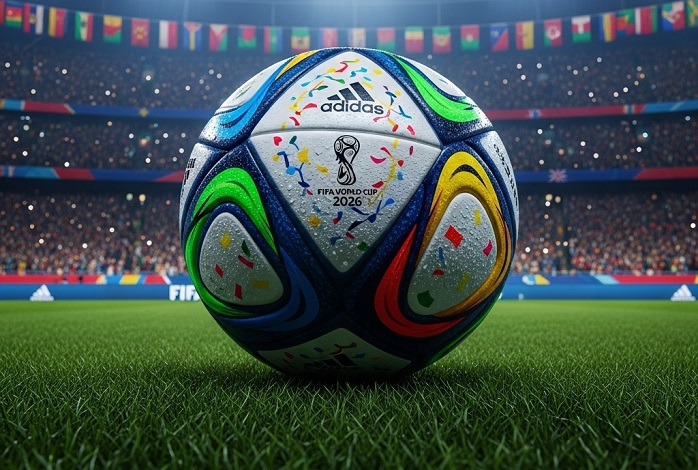Every FIFA World Cup writes its history not only through its matches, but through its ball. For 2026, Adidas is preparing a bold new chapter with the Trionda — a ball that seeks to blend national symbolism, aerodynamics innovation, and modern performance. The leaks and early previews already have fans buzzing. But will it live up to expectations? Let’s dive in.
🎨 Design & Symbolism: More Than Just Looks
From leaks and previews, here’s what we know about the Trionda’s look:
-
Name & Meaning: “Trionda” fuses “tri-”, reflecting the three host nations (USA, Mexico, Canada), with “onda” (wave in Spanish), hinting at fluid motion and unity. Footy Headlines+2Sohu+2
-
Color & Graphics: The ball will bear a predominantly white base, accented with red (Canada), green (Mexico), and blue (USA). Embedded graphics reflect each country: maple leaf motifs, stars, and Aztec inspired patterns. Global Scarves+3House of Heat°+3Footy Headlines+3
-
Panel Structure: A major technical shift — the Trionda reportedly uses only four thermally bonded panels, making it the lowest-panel count used in a World Cup ball ever. Scientific American+5SI+5Footy Headlines+5
-
Core & Surface: Early reports suggest a multi-layer tuned core and a textured skin (akin to Adidas’s SpeedShell style) for more stable flight and grip control. Global Scarves+1
The design is ambitious — combining national symbolism with streamlined performance. But bold design can also polarize opinions (some critics have already labeled it visually clashing). FourFourTwo
🚀 Performance & Physics: What Might Change
In terms of performance, what might the Trionda bring to the pitch?
-
Reduced Panel Count & Flight Behavior: Fewer panels aim to reduce seams and turbulence, ideally leading to more predictable trajectories. But making a near-spherical shape out of four curved panels is a scientific challenge. Footy Headlines+4Scientific American+4Global Scarves+4
-
Aerodynamics vs Drag: Because drag and airflow over the ball are influenced by its surface and seams, the Trionda design must carefully balance smoothness and texture to avoid too much “knuckling” (unpredictable swerves). Scientific American+2Global Scarves+2
-
Core & Consistency: The multi-layer core is expected to maintain consistent rebound and weight balance, especially important for high-level play under variable conditions (heat, humidity, altitude). Global Scarves+1
-
Sensor / Tech Integration: While no official confirmation, some leak reports hint the ball could include embedded sensors (500 Hz motion sensors) to assist VAR and ball tracking systems. Global Scarves
Compared to the recent Al Rihla (2022) with 20 panels and built-in inertial measurement tech, Trionda’s simpler panel scheme is a strong statement of confidence. SI+5Wikipedia+5Global Scarves+5
⚖️ Trionda vs Past World Cup Balls: Evolution & Trade-Offs
Looking at the lineage of World Cup balls helps assess where Trionda might succeed or stumble:
-
Brazuca (2014): Also had fewer panels (six) and was praised for stable flight and control. The Trionda essentially follows that spirit but pushes further to just four panels. House of Heat°+2Global Scarves+2
-
Al Rihla (2022): With many panels and connected ball tech, Al Rihla was engineered for speed and data connectivity. Trionda’s choice is almost the opposite direction — simplicity in panels, but with refined surface texture. SI+3Wikipedia+3Global Scarves+3
-
Jabulani (2010): Famously controversial for unpredictable flight and lack of control, largely blamed on its construction and surface. The Trionda designers must avoid repeating past mistakes. Scientific American+1
Thus, Trionda is walking a tightrope: offering a bold aesthetic and structural change, while trying to preserve playability, consistency, and player confidence.
🛒 Release, Editions & Collector Appeal
From leaks:
-
Launch Timing & Pricing: Expected to launch October–December 2025. The Pro edition is rumored around US$170. Global Scarves+3House of Heat°+3FootBoom+3
-
Official Editions: Likely “Pro” (match quality) and “League” or replica versions. Leaks show variants with raised motifs, textures, and branding differences. House of Heat°+2Footy Headlines+2
-
Collector Sets: Adidas is also preparing a Historical World Cup Ball Set (1970 to 2026) which will include the Trionda in its collection. Limited editions priced high as collector items. Footy Headlines
For fans and collectors, getting a Trionda “Pro” ball early, and perhaps a set, will be a way to own a piece of World Cup history.
👍 Pros, 👎 Cons & What to Watch
Pros:
-
Striking design that honors all three host countries in one unified graphic.
-
Fewer panels may yield smoother flight and consistent geometry.
-
Refined textures may help control, spin, and predictability.
-
High collector value, especially among fans of limited releases.
Cons / Risks:
-
The bold visuals may be divisive (some already call it visually busy or “an assault on the eyes”). FourFourTwo
-
Fewer panels means each panel is larger and curved — structural precision is critical; any flaw may affect performance.
-
If embedded sensors (for VAR, tracking) are included, that adds complexity and risks of failure.
-
The premium price may push many fans toward replica versions with reduced performance.
What to Watch:
-
How pro players react in early matches / friendlies.
-
Whether the sensor / tracking tech (if present) works reliably.
-
Durability of the surface under diverse climate conditions (heat, rain).
-
How affordable the league/replica versions are for fans.
💡 Trend Context & Why Trionda Matters
In 2025, football gear isn’t just about function—it’s about storytelling. The Trionda ball captures the spirit of tri-national unity, harnesses a trend toward minimal panel design, and serves as a canvas for branding. It also continues Adidas’s legacy of pushing ball technology while balancing art and science.
Fans are more tech-savvy, more demanding of aesthetics, and expect both performance and spectacle. The Trionda is Adidas’s attempt to satisfy all three host nations, global fans, and players alike.
✔ Final Verdict
The Adidas Trionda is shaping up to be one of the most talked-about World Cup balls ever. It’s bold in design, ambitious in engineering, and loaded with symbolism. If Adidas delivers on performance and reliability, it will be a worthy successor in the lineage of classic match balls.
But if flaws appear—in flight behavior, durability or sensor tech—it could draw criticism. For fans, though, the Trionda will likely be a must-own item: to kick with, to display, to collect.















